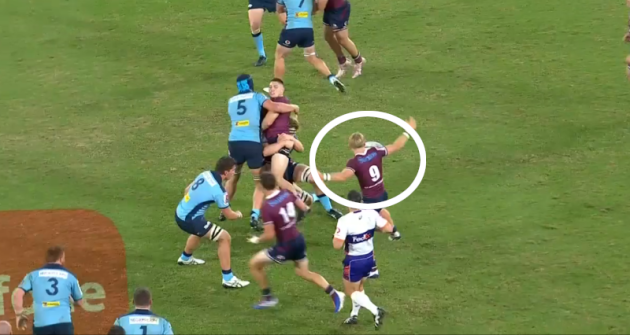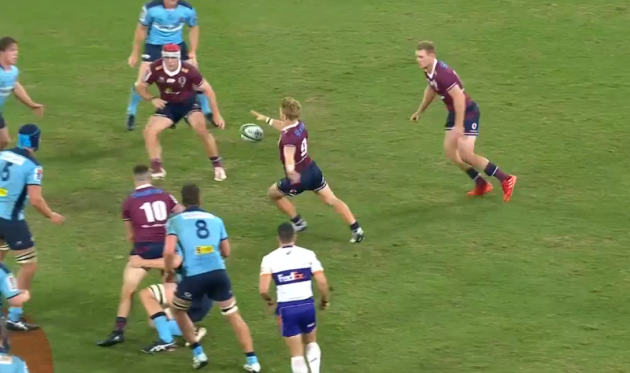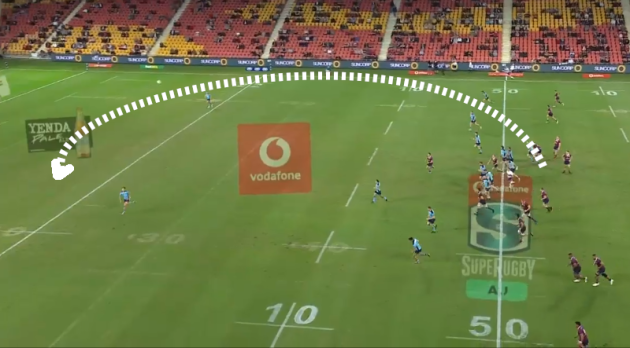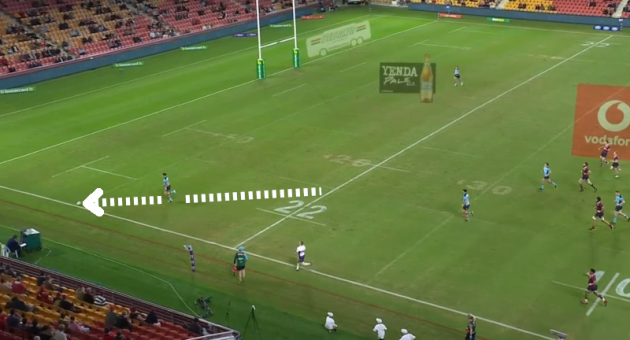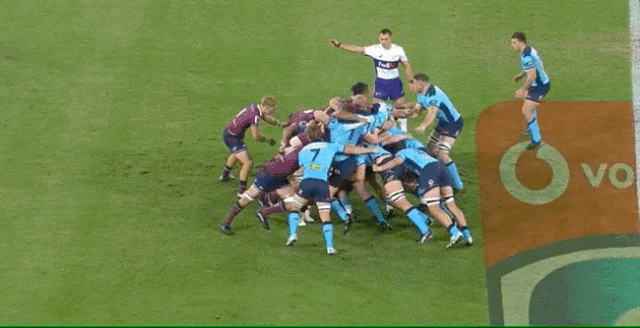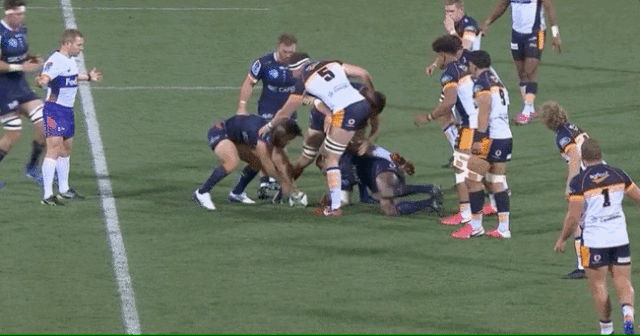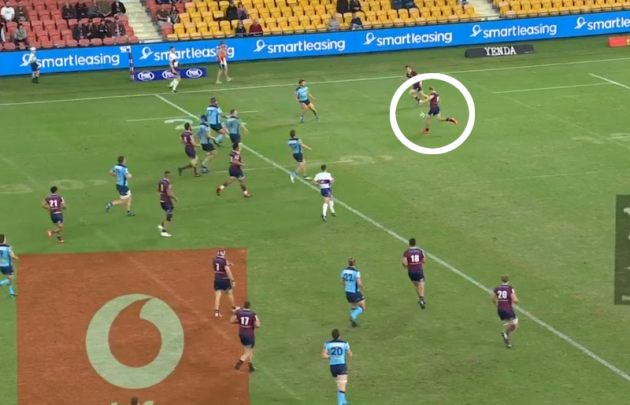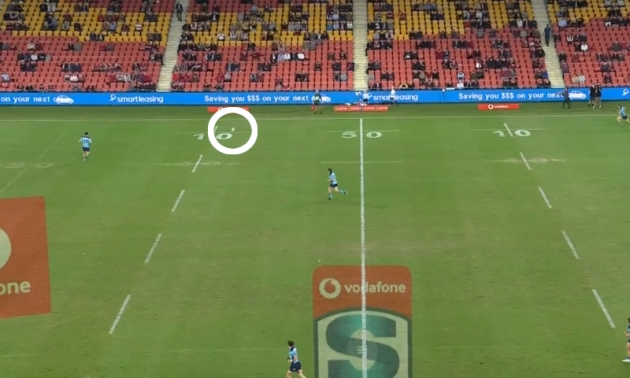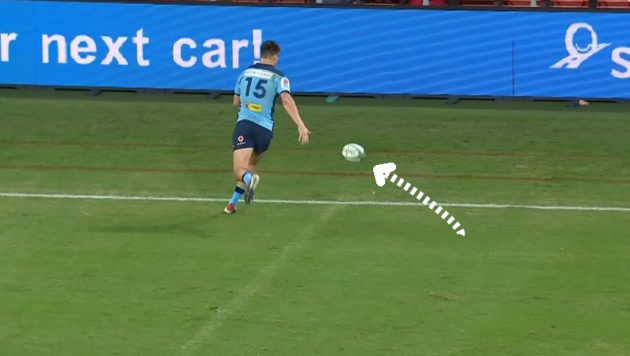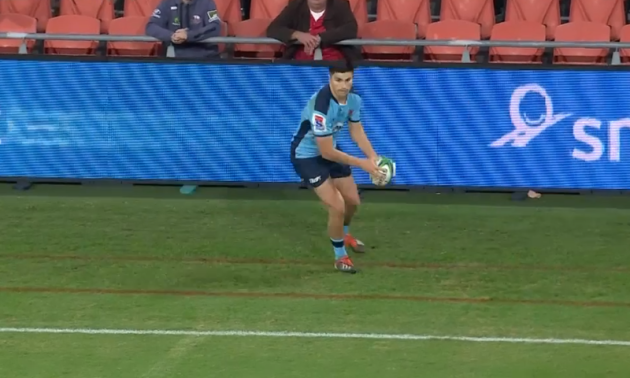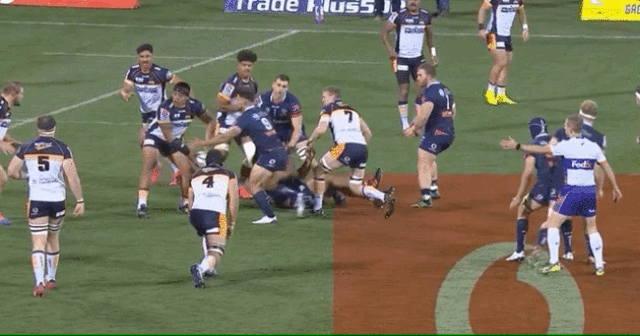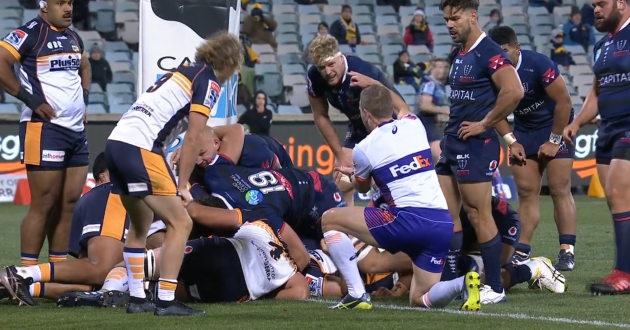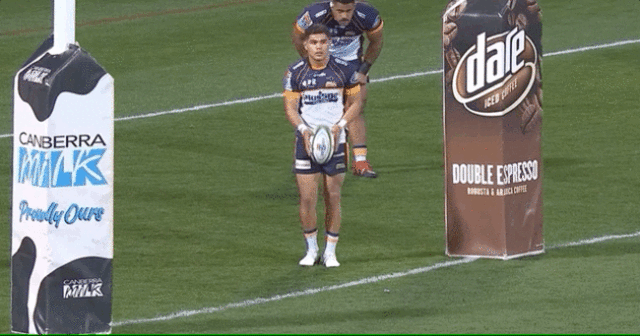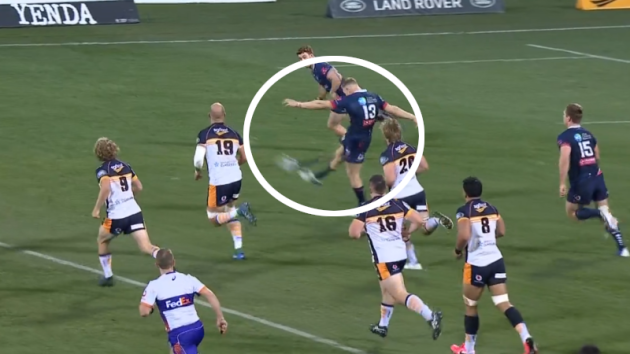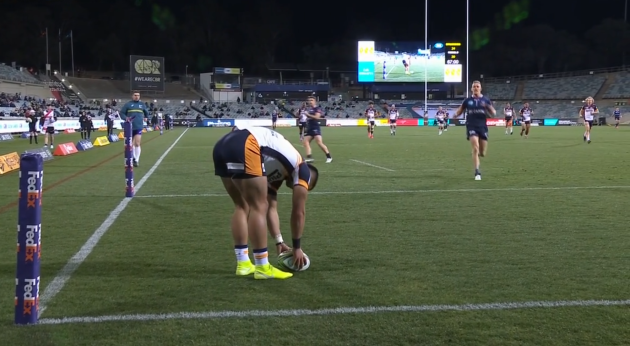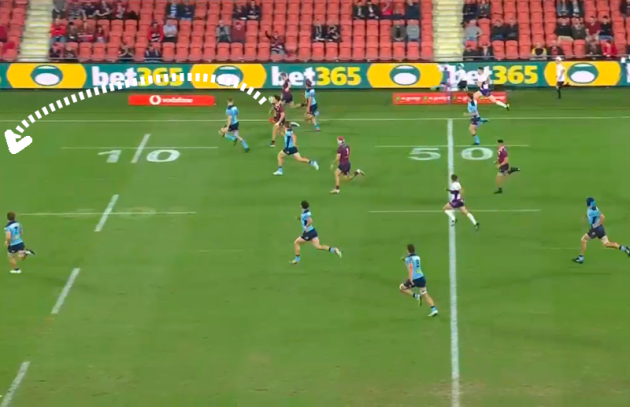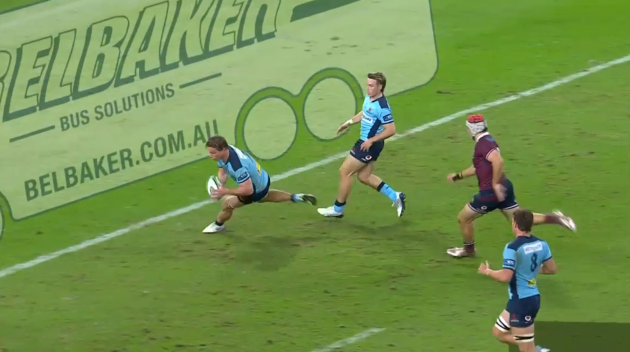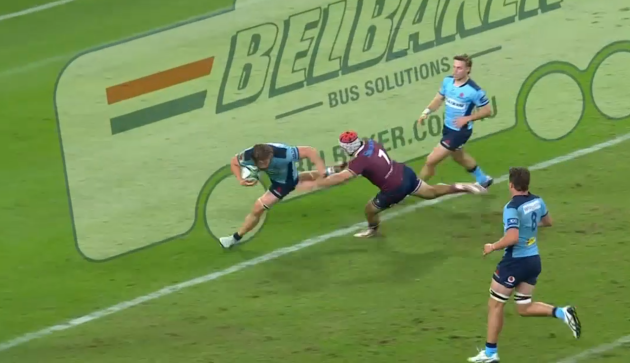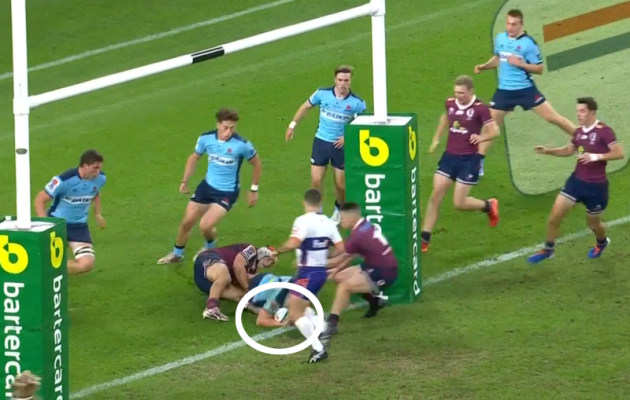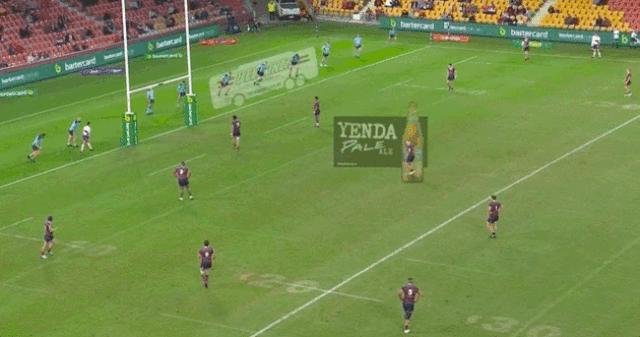THE OPENING WEEKEND of Super Rugby AU in Australia allowed us to get the first glimpse of some of the law trials that are being used in the competition.
Of chief interest ahead of the opener between the Reds and Waratahs on Friday was whether we would see a 50/22 kick. The encounter in Brisbane duly delivered.
50/22
This trial law means that if a player kicks the ball from inside their own half and it bounces before crossing the touchline inside the opposition’s 22, then the kicking team receives the throw-in to the lineout.
Existing rugby law means the non-kicking team receives the throw-in, so there is a major reward for the kicking side with this trial in Australia, which was also part of last year’s National Rugby Championship.
We had to wait until the second half of Friday’s Super Rugby AU opener to get our first example, with Reds scrum-half Tate McDermott the man to deliver.
Rather than being a clearly planned kick, it’s an off-the-cuff decision from McDermott, after he is initially surprised to got in the way of James O’Connor’s inside pass intended for wing Jock Campell…
McDermott swiftly reacts to gather the ball and launch a kick down into the Waratahs’ half…
McDermott kicks from around five metres inside his own half, cleverly kicking the ball back against the grain of the Reds’ left-to-right attacking movement.
McDermott finds space outside and beyond backfield defender Mark Nawaqanitawase, with the Reds scrum-half’s technique ensuring the ball rolls forward upon bouncing, all the way over the touchline.
The Reds are handed the throw-in to the ensuing lineout.
The shot above is a clear example of how advantageous the 50/22 law trial could be, even if the Reds failed to take their chance from 10 metres out in this instance.
Rugby Australia’s hope with this trial is that the threat of conceding lineouts in such dangerous positions will ensure defences operate with more players consistently in the backfield, in turn opening up space in the frontline of defences – which are often so good at stifling attacking play in the modern game.
The Australian union are hoping to see teams become strategic with their 50/22 kicking and one area where we could see more of it is from midfield scrums.
Indeed, we very nearly had an earlier example of a 50/22 kick in this game from one such situation. With advantage playing to the Reds at this scrum, out-half O’Connor comes close to pulling off a 50/22.
[Click here if you cannot view the clip above]
Although O’Connor’s kick comes up just short of reaching the 22, this example illustrates how midfield scrums could be a prime location for launching 50/22 kicks.
The defence has lots of ground to cover, while the attacking team can place kicking threats on either side of the scrum to offer different options.
There weren’t any successful 50/22 kicks in the second Super Rugby AU game of the weekend between the Brumbies and the Reds, but we did get a reminder of an important part of the new law trial in one example.
[Click here if you cannot view the clip above]
With the Rebels’ Matt Toomua kicking the ball inside his own half and bouncing it into touch inside the Brumbies’ 22, it initially looks like a 50/22 and the Rebels appeal for it.
However, assistant referee Amy Perrett and referee Angus Gardner inform them that it’s not a 50/22 because it was “taken back in” – i.e. that the Rebels passed the ball back into their own half of the pitch before kicking.
In this case, it doesn’t count as a 50/22 kick and the Brumbies throw into the lineout in their own 22.
22/50
We also saw the first example of a 22/50 kick in Friday’s opener between the Reds and Waratahs.
In this case, if a team kicks from inside their own 22 and the ball bounces before crossing the touchline inside the opposition half, the kicking team gets the throw-in to the lineout.
Reds fullback Bryce Hegarty collects the ball inside his own 22 after a kick by the Tahs and turns to respond in kind…
Hegarty gets good power into his kick and lands it infield just in front of the Tahs’ 10-metre line.
The ball bounces and begins rolling towards the touchline but Waratahs fullback Jack Maddocks seems to forget the new 22/50 law as he allows it to do so, even when he has time to prevent it from going into touch.
Maddocks then turns and looks to take a quick lineout…
… only to be stopped by referee Nic Berry and reminded, “22/50… he has kicked it inside his 22.”
The Reds get an attacking lineout just 30 metres out with the game tied at 26-26 in the 74th minute.
This situation makes it clear just how much of an advantage the Reds have gained from Hegarty’s kick and Maddocks’ error, but they overthrow the lineout and waste the opportunity.
In the second game of the weekend, we had another reminder about passing the ball back in before kicking, this time with the 22/50 law.
[Click here if you cannot view the clip above]
Andy Muirhead kicks from inside his 22 and bounces the ball into touch in the Rebels’ half but Perrett and Gardner once again point out that it was “taken back [into your own 22]“.
The Rebels get the throw-in to the lineout.
Goal line drop-out
Another new sight in Super Rugby AU this weekend was the goal line drop-out, with three examples in the two games.
The Brumbies had two of them, with the first coming after the Rebels had been held up over the Brumbies’ goal line.
Under existing rugby law everywhere else, this situation would have meant the Rebels getting a five-metre scrum.
However, in Super Rugby AU, one of the trial laws says that “when an attacking player carrying the ball is held up in the in-goal or knocks the ball on, play restarts with a goal line drop-out.”
So, instead of a Rebels five-metre scrum [and potentially a series of them], the Brumbies get a goal line drop-out and kick to the Rebels.
[Click here if you cannot view the clip above]
It’s a common sight for rugby league fans, of course, but the goal line drop-out is a new one for rugby union.
In this case, Brumbies out-half Noah Lolesio doesn’t make a great connection with the ball and Marika Koroibete is able to launch the Rebels back on the attack outside the 22.
Just to note, the goal line drop-out does not have to be taken from underneath the posts. It can be taken anywhere on or behind the defending team’s goal line and “must be taken without delay”. The defence must be at least five metres back from the goal line.
There was a second goal line drop-out in this game but in different circumstances.
In this instance, the Rebels get turnover ball from a Brumbies knock-on and Reece Hodge smashes a clearing kick downfield.
Hodge’s typically booming kick lands deep in the Brumbies’ half and bounces on forward…
… all the way into the Brumbies’ in-goal area, where it stops short of the dead-ball line.
With Hodge making a big effort to chase his kick, Brumbies wing Tom Wright grounds it, resulting in a goal line drop-out.
Under existing rugby law everywhere else, this action by Wright would result in a 22-metre drop-out, but the trial law in Super Rugby AU says that “when a kick enters the in-goal area and is forced by the defending team play restarts with a goal line drop-out.”
So, again, the Brumbies restart the game with a goal line drop-out.
[Click here if you cannot view the clip above]
The thinking from Rugby Australia with this variation may be to encourage attacking teams to attempt attacking kicks inside the opposition 22, rather than simply bashing through out-out phase after one-out phase.
Hodge’s kick here isn’t initially an obvious attacking one but it does end up ensuring the Rebels have attacking possession in a promising area of the pitch.
There was a goal line drop-out in Friday’s opener too but it was highly questionable.
In this instance, the Reds break down the right-hand side of the pitch before Hegarty chips a kick back infield.
Michael Hooper [yellow below] has worked back to cover and tracks the ball as it bounces and rolls towards the Waratahs’ in-goal area.
The ball takes another couple of bounces and then Hooper gathers it just before it enters the in-goal area.
At the moment above, the Reds’ kick has not ‘entered the in-goal area’.
Hooper is under instant pressure from the hard-chasing Reds flanker Fraser McReight as he then steps back into the in-goal area…
… where McReight completes his tackle and Hooper grounds the ball.
Referee Berry instantly whistles a halt to play and says, “Taken back, goal line drop-out.”
The difference here to the example from the other game is that Hegarty’s kick doesn’t enter the in-goal area.
Instead, Hooper collects the ball and then steps back into the in-goal area.
Given that this new law trial specifically states that “when a kick enters the in-goal area,” it appears that Hooper’s actions warrant the Waratahs conceding a five-metre scrum here.
A five-metre attacking scrum is obviously an extremely advantageous place to attack from but, instead, the Reds receive a goal-line drop-out.
Berry has had to work hard to track play here and Hooper is obviously very close to gathering in the in-goal area but the referee does not receive any communication from his television match official to give him a heads-up that the Waratahs flanker has gathered the ball outside the in-goal area and then stepped back into it.
[Click here if you cannot view the clip above]
Less than three minutes later, the Waratahs are down the other end of the pitch scoring a try.
Regardless of this questionable decision, it was intriguing to watch the other examples of the goal line drop-outs, as well as the 50/22 and 22/50 kicks in Super Rugby AU this weekend.
One final note on the attacking kicking front – a further law trial states that “a kick originating in the attacking 22m area cannot be marked by the defending team within their own 22m area. The kick can however be marked within the defending team’s in-goal area and play restarts with a 22m line drop-out.”
Again, this law trial seems intended to encourage attacking chip kicks and dinks in the opposition 22.
It will be intriguing to follow the progression of Super Rugby AU, noting if and how coaches and players figure out ways to take advantage of the new law trials.
